Cheerful CPU Cooler: Enermax ETS-T40-VD Review

The new Enermax cooler brings several new solutions to the cooling market. But will they work the way they are supposed to and which one of them will be the most useful for the users?
The Taiwanese Enermax Technology Corporation offers a pretty extensive variety of products. Over a period of more than 20 years Enermax introduced several lineups of power supply units, including server ones, various system cases, peripheral devices, unique cooling fans and, of course, CPU coolers.

Among the latter there are three so-called tower models with a vertical positioning of the heatsink in reference to the mainboard. They differ by fans and nickel-plating of the heatsink. These coolers are Enermax ETS-T40-VD, ETS-T40-TA and ETS-T40-TB. Today we are going to introduce to you the first cooler of the three.
Packaging and Accessories
The cooler ships in a cardboard box of medium size with an image of Enermax ETS-T40-VD on the top flap:
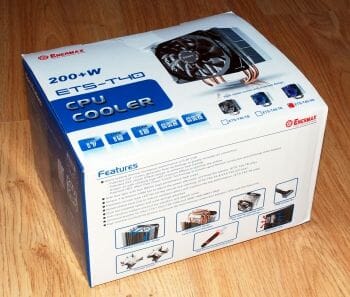
All other sides of the box are also pretty informative offering all the information about the cooler inside including its key features and technical specifications:
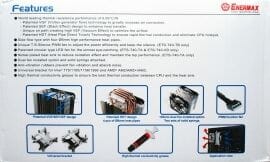
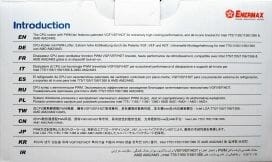
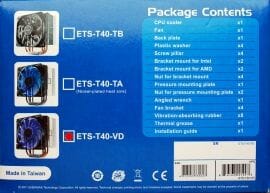
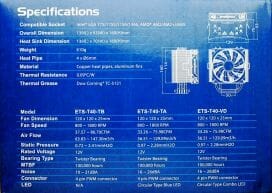
The package is quite secure and has additional internal separators protecting the cooler during transportation.
The accessories bundle that comes with the cooler includes the following components:
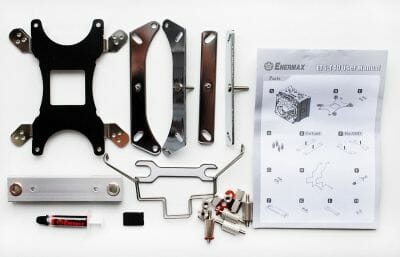
- Universal backplate with insulating padding;
- Two steel retention panels for Intel platforms;
- Two steel retention panels for AMD platforms;
- A retention bracket with locks;
- Two additional wire clips for the second fan;
- Dow Corning TC-5121 thermal paste (2.5 W/m°K);
- Four rubber shock-absorbing pads for the second fan;
- A set of threaded mounts, washers and screw-nuts and a special wrench for them;
- Installation manual in 12 languages.
The new cooler is manufactured in Taiwan and is priced at $43.99. We don’t know anything about the warranty, but it is most likely one year.
Design and Functionality
ETS-T40-VD is hardly any different from most other tower coolers and its heatsink consists of aluminum fins pressed against the heatpipes and a cooling fan:
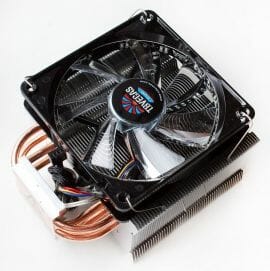
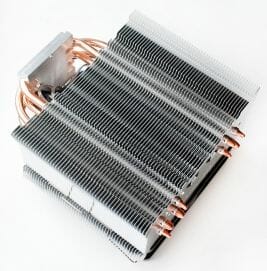
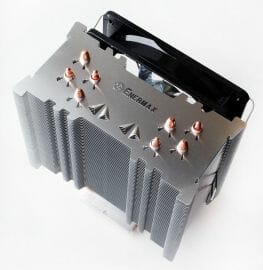
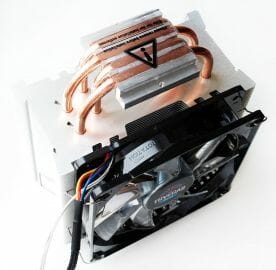
The cooler is 160 mm tall, which is quite normal for models like that. It is 139 mm wide and together with a fan and its rubber padding it is 93 mm deep:
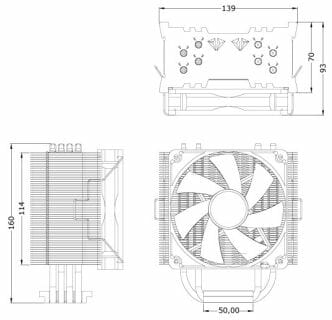
At the same time I have to say that the weight of 610 grams indicated in the cooler specifications is pretty modest for a cooler of this size. We double-checked it using an electronic scale and it came out to 737 grams without the fan, which, however, is still not too much anyway.
The heatsink fins array is very dense. It consists of 52 aluminum fins, each 0.4 mm thick, pressed against 6 mm heatpipes with 1.8 mm gaps between one another:
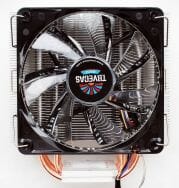
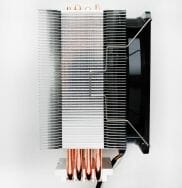
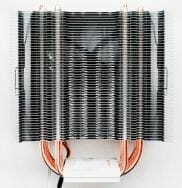
The calculated effective cooling surface of the heatsink is 8600 cm2. To lower the airflow resistance and increase the cooling efficiency, Enermax ETS-T40-VD heatsink boasts two types of optimizations to it.
First of all, there is a cut-out hollow in the center of the heatsink and a few additional notches in the fin edges on both sides, which lower the airflow resistance:
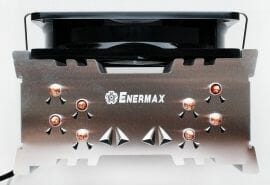
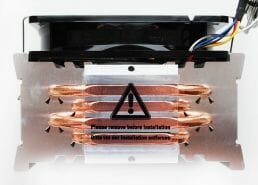
Secondly, there are four triangle holes in the central part of the heatsink fins – SFF (Stack Effect) and a pair of smaller holes of the same triangular shape next to each of the heatpipes – VGF (Vortex Generator Flow):
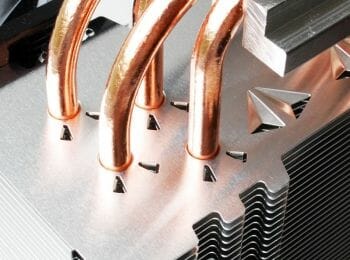
The latter are supposed to ensure more effective heat transfer from the heatsink fins rather than reduce the airflow resistance. We have already seen something like that in Thermalright coolers (HR-02 in particular). Moreover, the heatsink has one more optimization called VEF (Vacuum Effect). Namely, the side edges of the heatsink fins are bent downwards thus closing the gaps and ensuring that the airflow is concentrated on heatpipes and fins. Note that the heatpipes are aligned inside the heatsink array in staggered order ensuring more even heat distribution over the heatsink.
The Enermax ETS-T40-VD heatsink has four heatpipes. The cooler is built using HDT (Heat Pipe Direct Touch) technology. Unfortunately, its implementation is more typical of the very first products with heatpipe direct touch, because the gaps between the heatpipes in the base are 2.1 mm big and filled with aluminum inserts:
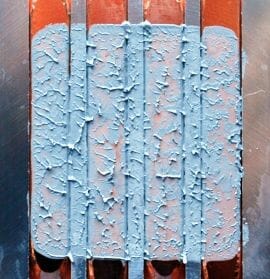
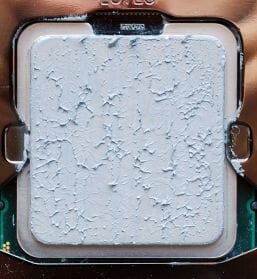
Many cooling solution makers are already switching to second-generation direct touch, when there are no inserts of any kind between the heatpipes, or they are less than 1 mm wide. Enermax is about 2 years behind in this respect. Moreover, there are only four heatpipes, which is not enough to ensure efficient and most importantly even heat removal from the heat-spreaders of contemporary processors.
Enermax ETS-T40-VD is equipped with one 120 mm fan – U.R.VEGAS. It has four clear blades and a black frame:
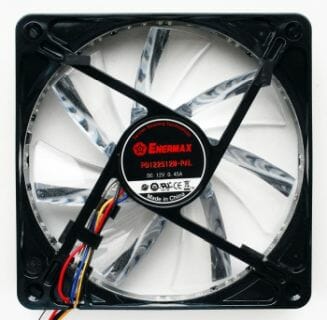
The fan rotation speed is adjusted using pulse-width modulation method in the interval between 800 and 1800 RPM at 16-26 dBA of noise. The declared airflow is 33.26-75.98 CFM and the static pressure is promised at 0.97-2.28 mmH2O.
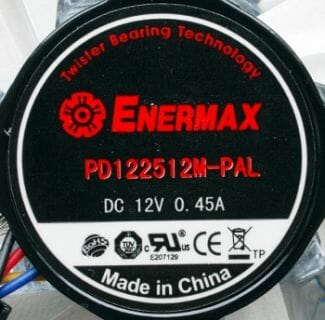
The fan uses a brand name Twister bearing, which is expected to last 100,000 hours or over 11 years of non-stop operation. At the same time, the fan’s startup voltage turned out pretty low – only 3.4 V and the maximum power consumption, which was supposed to be 5.4 W, didn’t exceed 4.5 W. Moreover, you can remove the fan impeller for servicing if necessary.
There are a lot of LEDs on the inside of the fan frame:
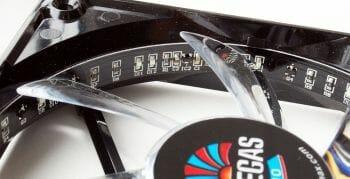
The user can select one of the seven lighting options with a button-switch. All of them look pretty awesome.
Compatibility and Installation
Like many new coolers from this price range, Enermax ETS-T40-VD is compatible with all contemporary platforms. Nevertheless, I can’t help mentioning that it doesn’t yet support LGA 2011 platform. The installation procedure is described in detail in a multi-lingual manual available for download on the official web-site.
To install the cooler on any of the platforms you will have to use the universal backplate with retention holes for any type of the processor socket:

It is made of steel and is double-sided, but the insulation padding is also available on both sides, so you don’t need to worry about interfering with any of the electronic components on the back of the mainboard PCB:
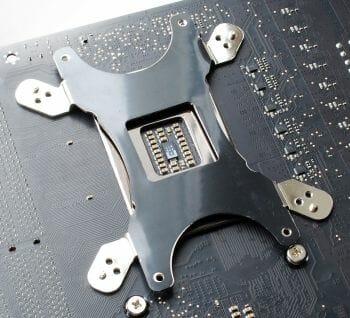
The installation procedure is the same for Intel and AMD processors:
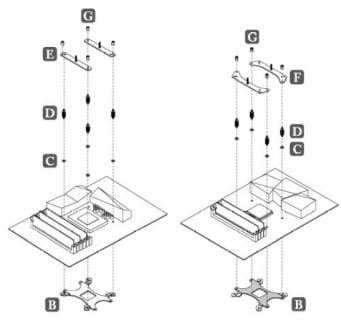
I would only like to add that it is easier to install the heatsink alone and then attach the fan(s) to it.
First of all we insert the threaded mounts through the insulated washers into the backplate installed on the back side of the mainboard PCB. After that we place the steel panels on the mounts accordingly:
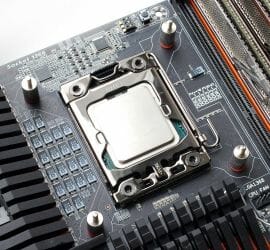
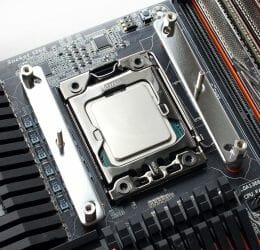
The next step is to apply a thin and even layer of thermal paste onto the processor heat-spreader and after that install the cooler and fasten it in place with a retention bracket and two screw-nuts using a screw-driver or a wrench:
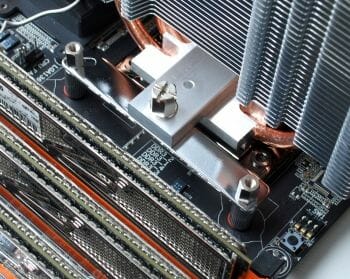
This retention provides very strong hold and the whole thing even bends a little. However, the mainboard PCB doesn’t deform due to the backplate that does its job perfectly.
The last thing to do is to attach the fan to the heatsink with two wire clips. Just make sure you get the airflow direction right:
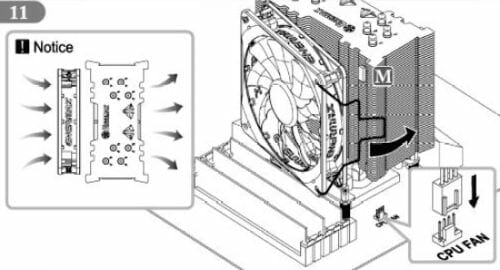
That’s it. Enermax ETS-T40-VD is ready to fire up:
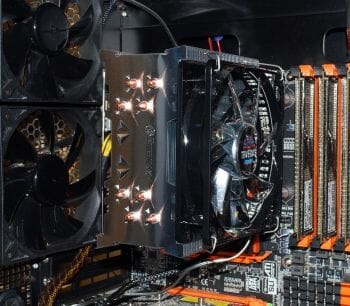
In conclusion I would like to add that the distance from the lower heatsink fin to the mainboard PCB is 45 mm and the fan is hanging another 5 mm lower. The cooler doesn’t block the DIMM slot closest to the processor socket.
Technical Specifications and Recommended Pricing
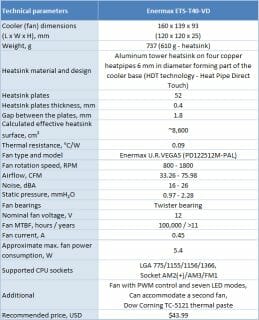
Testbed and Testing Methodology
We performed all cooler tests inside a closed system case. Here is our testbed configuration:
- Mainboard: Gigabyte GA-X58A-OC (Intel X58 Express, LGA 1366, BIOS F5c from 09/06/2011);
- Processor: Intel Core i7-980X Extreme Edition, 3.33 GHz, 1.225 V, 6 x 256 KB L2, 12 MB L3 (Gulftown, B1);
- Thermal interface: ARCTIC MX-4;
- Graphics card: ATI Radeon HD 5770 1 GB GDDR5 128 bit, 850/4800 MHz (with a passive heatsink from the DeepCool V4000 VGA cooler);
- Memory: DDR3 3 x 2 GB OCZ Platinum Low-Voltage Triple Channel (Spec: 1600MHz / 7-7-7-24 / 1.65 V);
- System drive: RAID-0 of 2 x Kingston V-series SNV425S2128GB SSD (SATA-II, 128 GB, MLC, Toshiba TC58NCF618G3T controller);
- Drive for programs and games: Western Digital VelociRaptor (300GB, SATA-II, 10000 RPM, 16MB cache, NCQ) inside Scythe Quiet Drive 3.5” HDD silencer and cooler;
- Backup drive: Samsung Ecogreen F4 HD204UI (SATA-II, 2 TB, 5400 RPM, 32 MB, NCQ);
- System case: Antec Twelve Hundred (front panel: three Noiseblocker NB-Multiframe S-Series MF12-S2 fans at 1020 RPM; back panel: two Noiseblocker NB-BlackSilent PRO PL-1 fans at 1020 RPM; top panel: standard 200 mm fan at 400 RPM);
- Control and monitoring panel: Zalman ZM-MFC2;
- Power supply: Xigmatek “No Rules Power” NRP-HC1501 1500 W (with a default 140 mm fan).
We overclocked our six-core processor (with its default non-lapped heat-spreader) with the multiplier set at 25x and “Load-Line Calibration” (Level 2) enabled to 4.2 GHz. The nominal processor Vcore was increased to 1.35 V in the mainboard BIOS:
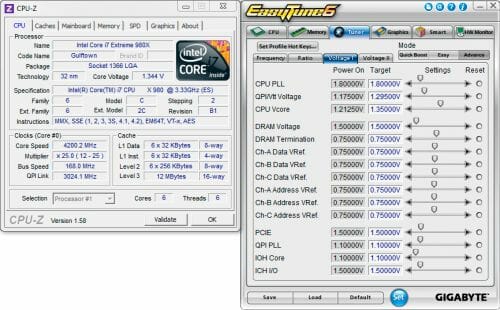
Turbo Boost and Hyper-Threading technologies were disabled during our test session. The memory voltage was at 1.5 V and its frequency was 1.344 GHz with 7-7-7-16_1T timings (Extreme profile). All other parameters available in the mainboard BIOS and related to CPU or memory overclocking remained unchanged.
All tests were performed under Windows 7 Ultimate x64 SP1 operating system. We used the following software during our test session:
- CPU Stress Test (CST) version 0.18b – to load the processor (matrix # 15, 10-12 minutes);
- Real Temp GT 3.64 – to monitor the processor core temperature;
- CPU-Tweaker 1.5 – to visually monitor temperatures and frequencies using graphics;
- Gigabyte Easy Tune 6 B11.0823.1 – to monitor voltages.
So, the complete screenshot during the test session looks as follows:
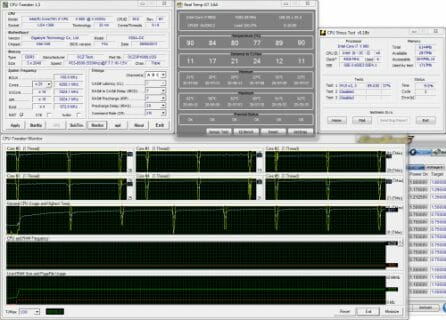
The CPU was loaded with two consecutive CST test runs with the settings as indicated above. The stabilization period for the CPU temperature between the two test cycles was about 8-10 minutes. We took the maximum temperature of the hottest CPU core for the results charts. Moreover, we will also provide a table with the temperature readings for all cores including their average values. The ambient temperature was checked next to the system case with an electronic thermometer with 0.1 °C precision that allows hourly monitoring of the temperature changes over the past 6 hours. The room temperature during our test session varied between 23.7-24.2°C.
The noise level of each cooler was measured between 1:00 and 3:00 AM in a closed room about 20 m2 big using CENTER-321 electronic noise meter. The noise level for each cooler was tested outside the system case when the only noise sources in the lab were the cooler and its fan. The noise meter was installed on a tripod and was always at a 150 mm distance from the cooler fan rotor. The tested cooling systems were placed at the edge of the desk on a sheet of polyurethane foam. The lowest noise reading our noise meter device can register is 29.8 dBA and the subjectively comfortable noise level in these testing conditions was around 36 dBA (do not mix it up with low noise level). The fan(s) rotation speed was adjusted in the entire supported range using our in-house controller by changing the voltage with 0.5 V increment. The fan rotation speed increment equaled 200 RPM (±10 RPM).
We are going to compare Enermax ETS-T40-VD against two coolers. The first one is the inexpensive Thermalright True Spirit ($29.95):
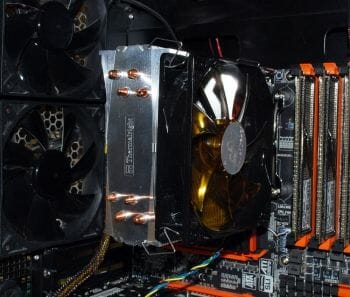
Besides we also included the results of the similarly priced Thermalright HR-02 Macho ($40). Both coolers are efficiency leaders in their respective price ranges, although their prices are not too different after all.
Cooling Efficiency Tests
The results of our cooling efficiency tests are summed up in the diagram and table below:
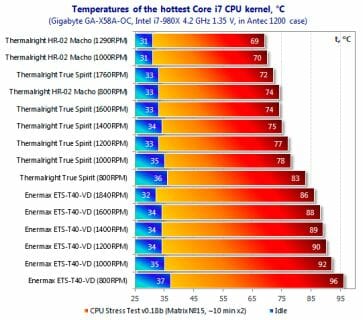
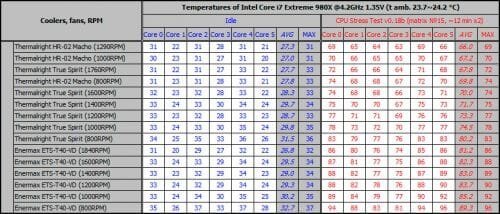
Well, what can I say? You see everything with your own eyes: Enermax ETS-T40-VD suffers a devastating defeat not only from Thermalright HR-02 Macho with the same exact price tag, but even from the less expensive True Spirit, too. Under peak operational load even at maximum rotation speed of its default fan (1840 RPM) the new Enermax cooler yields 3°C to True Spirit with the fan rotating at its minimal speed of 800 RPM. This is not a good situation for the ETS-T40-VD. It looks like this cooler is unable to cope even with moderately overclocked six-core processors.
I have to admit that we did everything we could to improve the cooling efficiency of this product. The use of two fans instead of one delivered a 2-degree increase in efficiency under maximum load on the hottest processor core, which indicates that the heatsink is indeed well optimized and doesn’t depend too much on the airflow speed and volume. Moreover, we replaced the default Enermax ETS-T40-VD thermal paste – Dow Corning TC-5121 – with ARCTIC MX-4, and the cooling efficiency dropped by 3°C on the maximum temperatures, which is quite logical considering the heat conductivity of these two thermal interfaces. Finally, the cooler was removed and installed fresh multiple times and even rotated 90° in an attempt to find a better positioning of the heatpipes in respect to the processor heat-spreader. But all these efforts were vain. I believe the obtained results are indeed the best Enermax ETS-T40-VD can do.
That’s a real pity, but there is nothing else we can do at this point. Let’s move on to the acoustic performance of the newcomer.
Acoustic Performance
We measured the acoustic performance of our today’s testing participants in the entire rotation speed range of their fans. The results are summed up on the following graph:
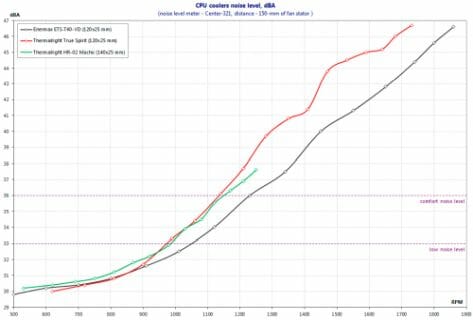

One thing Enermax ETS-T40-VD really can be proud of is the exceptional fan. It not only lights up in very entertaining patterns, but also works very quietly. As we know, the fans on both Thermalright coolers are among the best out there, but despite that fact Enermax fan demonstrated even more impressive combination of speed and acoustics. Up to 1230 RPM the fan remains acoustically comfortable, and up to 1050 RPM you can barely distinguish its noise at all against the background of a quiet system case. There is no crackling, howling, beating or jingling of the fins. Overall, Enermax ETS-T40-VD deserves an A+ for the noise test.
Conclusion
So why did we call Enermax ETS-T40-VD “cheerful”? The answer is obvious: its bright, colorful, diverse LED lighting will definitely catch your eye even on the gloomiest day and make you smile. At least this was the reaction this cooler got from everyone who saw it in action. And some of the people who saw it had nothing to do not only with the cooling products, but even with computer components in general. So, if you are looking for a solution that would cheer you up like that, then Enermax ETS-T40-VD is an ideal option.
Since we didn’t uncover any serious issues with the Enermax ETS-T40-VD heatsink design and structure, the reasons for its unimpressive performance must lie with the direct touch technology, namely, the particular implementation of this technology in the ETS-T40-VD. The gaps between the heatpipes in the base are way too wide, which doesn’t allow the cooler to quickly and evenly remove the heat from the heat-spreader of a powerful CPU. As a result, this is what we got and Enermax ETS-T40-VD is simply unable to deliver more. We also suspect that the heatpipes might be not the most efficient ones, but we can’t confirm or deny this assumption for obvious reasons.
Nevertheless, we should give this product due credit for its universal design, simple and very reliable retention with strong hold, superior fan with elaborate LED lighting, sturdy and informative packaging and very competitive price.